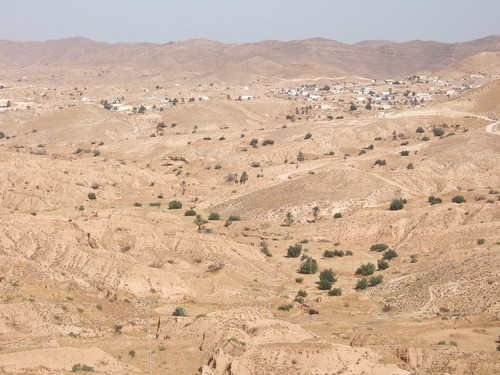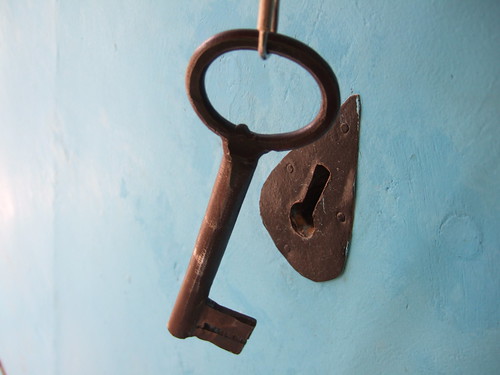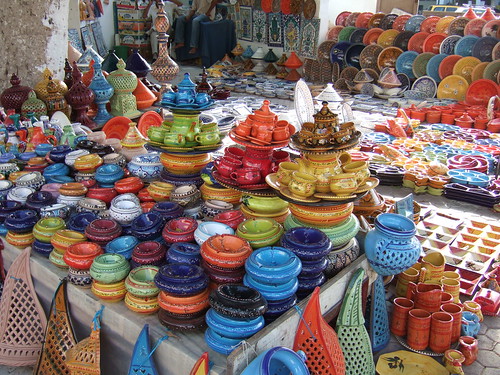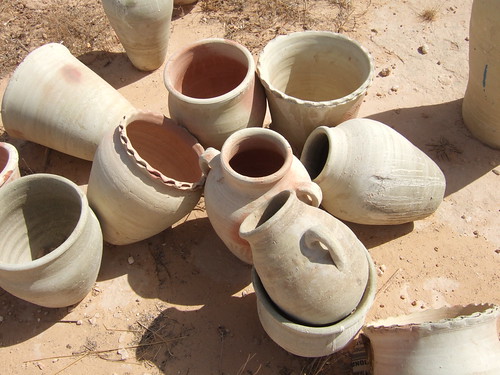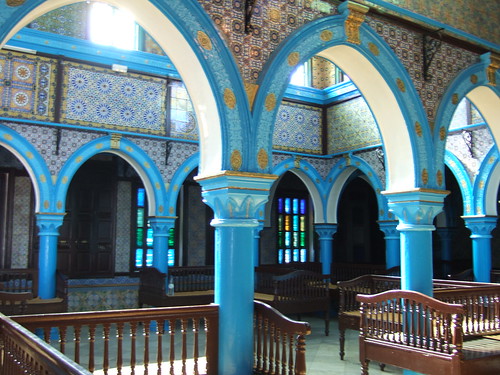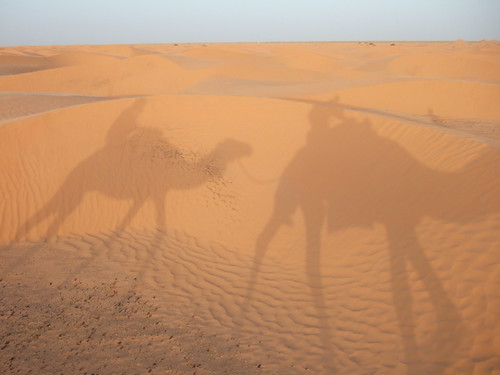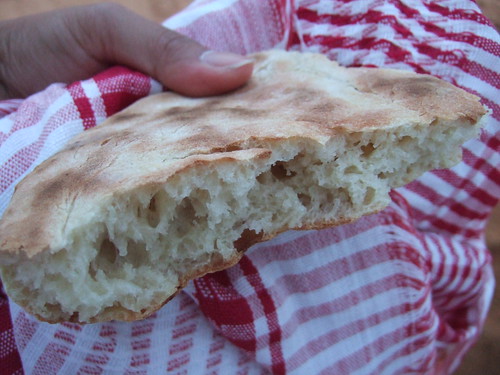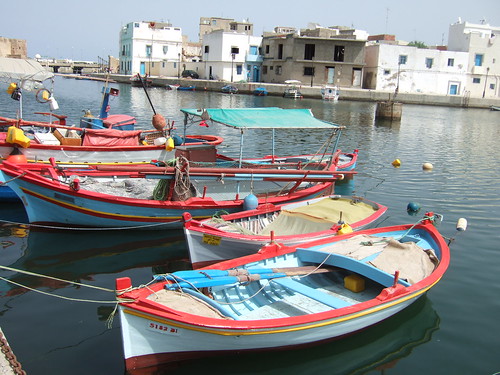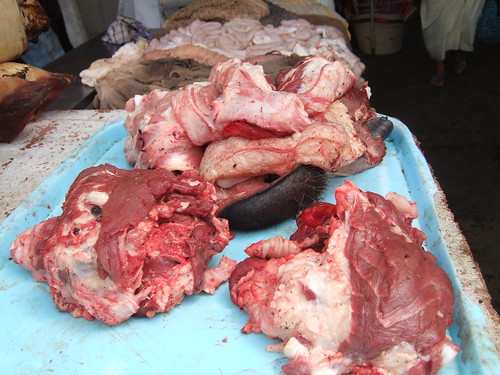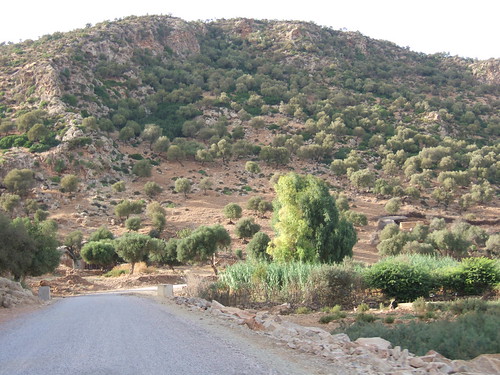We slept some more as Taha and Emin drove us the next morning to Matmata. The roads started to disappear and this is why only 4x4s are allowed in the desert. More camels and rosemary bushes dotted the side of the road. From the top of Matmata, we saw how Mother Nature carved stones and created sand mountains. Matmata is known for its troglodyte homes built underground to provide respite from hot summers and random invasions. Hotel Sidi Driss, five pit courtyards connected by underground tunnels, was where–surprise–Star Wars was shot. Tourists go in and out of the hotel to take photographs and have pushed the locals to the Nouvelle Matmata on the other side of town.
As we were leaving Matmata, we asked Taha about Gabes. He said there is absolutely nothing to see there. (What? He didn’t mention that it was Obi-Wan’s home!) We checked our map and wondered about the island of Jerba jutting out of Gabes. According to legend, Ulysses stopped there in the course of the Odyssey to persuade his crew to get back on board after the natives, or the “lotus-eaters”, gave his men flowering food that made them forget about going back home. How awesome is that tidbit? It is now one of the last places in Tunisia where Muslims and Jews peacefully live side by side. We were definitely intrigued.
Taha turned our SUV around and stopped another car he happened to know was going to Jerba. A young Japanese couple was inside and we introduced ourselves as our drivers talked. Luckily, the Japanese agreed to give us a ride to Jerba. They really had no chance to say no as their driver started loading our backpacks in the back of their car. The ride was quiet, but it became less awkward as soon as the Japanese started talking to us. We found out that they have been with their driver for the last four days and were also fasting with him. Like their driver, they were on their fourth day of Ramadan. It was a noble gesture, something we couldn’t even imagine doing during a vacation, and it surely broke the ice. The driver said, Filipinos? Thumbs down. Japanese? They do Ramadan with me! and gave them a thumbs-up.
About an hour and a half later, we boarded the ferry to Jerba. From Jerba, we entered the town of Ajim and were dropped off at Houmt Souq, the city center. (Note to Jase: Ajim was also Mos Eisley.) In the heat, we carried our packs to Hotel Arischa, an old funduq with a 56-dinar nightly rate. A funduq was an inn where traveling merchants stopped by to rest during the Ottoman period. The gate was big enough to accommodate camels and their load. The first floor was usually a warehouse where the animals’ needs were stocked and the second floors were the sleeping quarters. Each door came with giant locks and barrel bolts. We decided to spend two days to enjoy the town’s souqs, or markets, and the island’s beaches. Hotel Arischa became our favorite accommodation.
Now without a car, we had to hire a cab to take us to the public beach. The beach was disappointingly full of litter, so we ended up walking to the beachfront of the Radisson Hotel where several Europeans were already red from too much sun. It was like entering a music video, with shady tents, a large turquoise pool and staff clad in all white serving cocktails on trays. We paid 30 dinars for a mojito and a caipirinha. Alas, we had to pay New York prices for a little bit of sin in a Muslim country.
Back in town, we walked in and out of the covered souqs to see the potential souvenirs we may be able to take home. Each town has its specialty, but most of the time, sellers offer the same products: clay pots, tagines, shisha pipes and leather poofs. From all the towns we’ve visited so far, we’ve enjoyed the produce markets more than the shops. In Houmt Souq, we watched the fish auction. Men who sat on elevated chairs displayed strings of fish provided to them by their fishermen. Bidders, which include restaurant owners to housewives, shouted out a price to buy the freshest of the fresh. We noticed that one of the auctioneers had a jasmine flower behind his right ear. I later read that if a Tunisian man has a jasmine flower behind his right ear, he is single and is looking for a wife. (Guess where the Dr. put his jasmine?) A man who puts a flower behind his left ear is proud to be taken and married.
We craved seafood after visiting the fish market. Dinner was at Restaurant D’Ille, a recommendation from one of the funduq employees. The sea bass we ordered for 10 dinars was so small, it didn’t look like the sea bass we were familiar with. We just figured that they had a different translation for the real sea bass. We ordered two beers and a half bottle of a very strong rose wine. Together with another plate of lamb and couscous, our meal was a splurge for 56 dinars.
It was hard to explore the rest of the island without a car. It didn’t take us a long time to succumb to the idea of renting another car that we can drive all the way back to Tunis. The next morning after breakfast, we picked up a new rental from Europcar. We drove to the La Seguia beach where we sat by the channel and watched an old man fish all morning. Stupid jet skiers disturbed the peacefulness. We swam for a bit and read and sunbathed.
Then we drove to the south, with a stop at the Cave d’Ali Berber where a guide showed us a typical Berber home, and an underground tunnel where he gets clay for his pottery. I was a tourist, so I was forced to feed a baby camel. We bargained for a cooking tagine for 25 dinars. Later, we found out the same tagine cooker started at 35 in the souqs, but if you start to walk away, the desperate sellers can go as low as 10 dinars. I’m usually good at bargaining, but it was difficult to haggle when you’ve been cornered inside their store and when they block your way out.
We also drove near the water to see the unkept Guellala Mosque. Our next stop was the Jewish synagogue of El-Ghriba, an important place of pilgrimage during Passover. It was bombed in 2002, so visitors now have to go through the X-Ray machines before entering. We took off our shoes and wore head coverings before we walked in to listen to the old men read aloud from the holy book. We also checked out the metal hangings left by devout pilgrims. The sanctuary reportedly has one of the oldest Torrahs.
For the rest of our last day in Jerba, we planned our final week in Tunisia. Dinner was at Restaurant Les Palmiers. For 17 dinars, we ate the usual salade Tunisienne, rice with lamb stew and a grilled dorade. It was a warm, breezy night. We sat outside and joined the men for the night’s mint tea while the mosque next door announced that Allah is great.
Related post/s:
Day 6 in Tunisia: Matmata photos on Flickr
Day 6, 7 & 8 in Tunisia: Jerba Island photos on Flickr
Day 5: Chott el-Jerid to Douz to Ksar Ghilane, Tunisia
